
The Italian Riviera or Ligurian Riviera is the narrow coastal strip in Italy which lies between the Ligurian Sea and the mountain chain formed by the Maritime Alps and the Apennines. Longitudinally it extends from the border with France and the French Riviera near Ventimiglia eastwards to Capo Corvo which marks the eastern end of the Gulf of La Spezia and is close to the regional border between Liguria and Tuscany. The Italian Riviera thus includes nearly all of the coastline of Liguria. Historically the "Riviera" extended further to the west, through what is now French territory as far as Marseille.

The Chelsea Physic Garden was established as the Apothecaries' Garden in London, England, in 1673 by the Worshipful Society of Apothecaries to grow plants to be used as medicines. This four acre physic garden, the term here referring to the science of healing, is among the oldest botanical gardens in Britain, after the University of Oxford Botanic Garden. Its rock garden is the oldest in Europe devoted to alpine plants and Mediterranean plants. The largest fruiting olive tree in Britain is there, protected by the garden's heat-trapping high brick walls, along with what is doubtless the world's northernmost grapefruit growing outdoors. Jealously guarded during the tenure of the Worshipful Society of Apothecaries, the garden became a registered charity in 1983 and was opened to the general public for the first time.
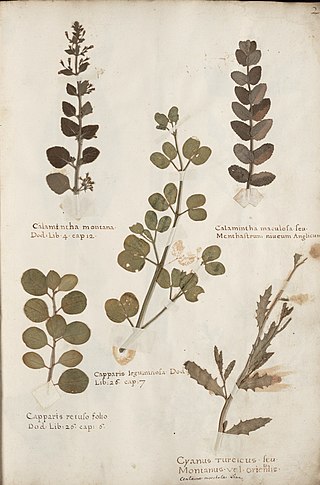
A herbarium is a collection of preserved plant specimens and associated data used for scientific study.

Ventimiglia is a resort town in the province of Imperia, Liguria, northern Italy. It is located 130 km (81 mi) west of Genoa, and 7 km (4.3 mi) from the French-Italian border, on the Gulf of Genoa, having a small harbour at the mouth of the Roia river, which divides the town into two parts. Ventimiglia's urban area has a population of 55,000.

The province of Imperia is a mountainous and hilly province in the Liguria region of Italy, situated between France to the north and the west, and the Ligurian Sea, an arm of the Mediterranean Sea to the south. Its capital is the city of Imperia.

Alwin Berger was a German botanist best known for his contribution to the nomenclature of succulent plants, particularly agaves and cacti. Born in Germany he worked at the botanical gardens in Dresden and Frankfurt. From 1897 to 1914 he was curator of the Giardini Botanici Hanbury, the botanical gardens of Sir Thomas Hanbury at La Mortola, near Ventimiglia in northwestern Italy, close to the border with France. After working in Germany from 1914 to 1919, Berger studied in the United States for three years, before spending his final years as director of the department of botany of the natural history museum in Stuttgart

Syagrus romanzoffiana, the queen palm or cocos palm, is a palm native to South America, introduced throughout the world as a popular ornamental garden tree. S. romanzoffiana is a medium-sized palm, quickly reaching maturity at a height of up to 15 m (49 ft) tall, with pinnate leaves having as many as 494 pinnae (leaflets), although more typically around 300, each pinna being around 50 centimetres (18 in) in length and 3–5 centimetres (1–2 in) in width.

Moritz Kurt Dinter was a German botanist and explorer in South West Africa.
The Giardino Botanico Rea is a botanical garden located 450 meters altitude in Val Sangone, at Trana, Province of Turin, Piedmont, northern Italy.
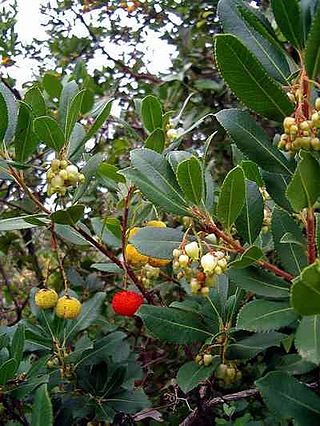
The flora of Italy is all the plant life present in the territory of the Italian Republic. The flora of Italy was traditionally estimated to comprise about 5,500 vascular plant species. However, as of 2019, 7,672 species are recorded in the second edition of the flora of Italy and in its digital archives Digital flora of Italy. In particular, 7,031 are autochthonous and 641 are non native species widely naturalized since more than three decades. Additionally, further 468 exotic species have been recorded as adventitious or naturalized in more recent times.

Ludwig Winter was a German botanist, nurseryman and landscape designer, creator of gardens such as the Giardini Botanici Hanbury, noted for introducing tall palms and other foreign species to the Ligurian riviera.

Daniel Hanbury FRS was a British botanist and pharmacologist. He was an early student of pharmacognosy, the study of the medicinal applications of nature, principally of plants.

Sir Thomas Hanbury was an English businessman, gardener and philanthropist. He built the Giardini Botanici Hanbury, or Hanbury botanical gardens, at Mortola Inferiore, between Ventimiglia and Menton, on the coast of Italy near to the border with France.

Mortola Inferiore, often known as La Mortola, is a frazione of the comune of Ventimiglia, in the province of Imperia, in Liguria, Italy. It lies on the road from Ventimiglia to the French border. It is home to the Giardini Botanici Hanbury, or Hanbury botanical gardens, created in the 19th century by Sir Thomas Hanbury.
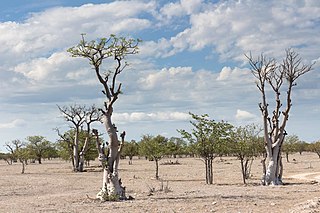
Moringa ovalifolia is a succulent flowering tree of the family Moringaceae native to Namibia and southwestern Angola.
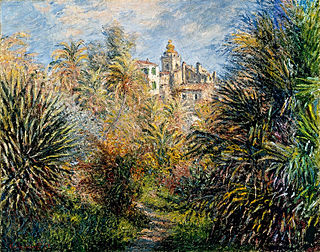
The Moreno Gardens of Bordighera which were described by many tourists in the 19th century, no longer exist. Only a small portion survives as today’s Monet gardens, which are located in Via Domenico Tumiati, and in some private properties. The remainders of the Moreno Gardens and Villa Palmizi are part of the properties protected by the Superintendent of Ministry of Cultural Heritage and Activities and Tourism (Italy).
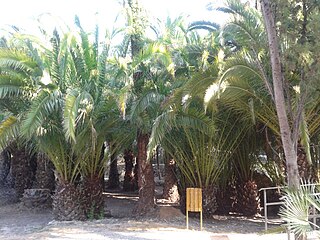
The Winter Gardens were created by the German botanist Ludwig Winter and they are located at 6, Via Ludovico Winter in Bordighera, Liguria, Italy.

Grimaldi is a frazione of 281 inhabitants in the municipality of Ventimiglia, in the province of Imperia. It is located near the French border of Ponte San Luigi. The oldest inhabited centre, located at 220 m, takes the name of Grimaldi Superiore, to distinguish it from the houses built along the State Road 1 (SS1) Aurelia, which makes up Grimaldi Inferiore.
























